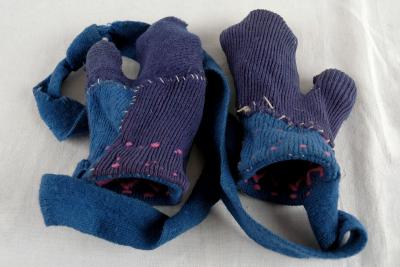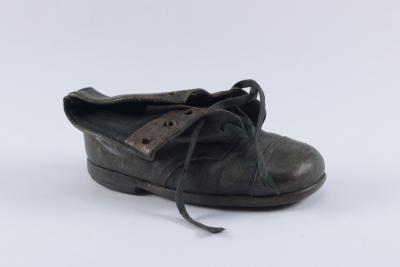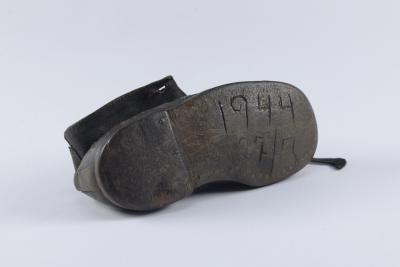Introduction
This article focuses on the shoe and mittens of the toddler Hinda Cohen, deported to Auschwitz in a children’s aktion (action, or round-up) that occurred in the Kovno Ghetto, on March 27, 1944. Hinda was murdered in Auschwitz.
When Hinda was taken from her bed to be deported to Auschwitz, her shoe was left behind. Upon finding it, her father etched the date on the shoe’s sole. Her parents, Dov and Zipora Cohen, survived the war. They kept their daughter’s shoe, the pair of mittens that Zipora had sewn for her from scraps of material, and her birth certificate, until they died.
The Story
Zipora and Dov (Braka) Cohen were a young couple at the outbreak of World War II. Before the war, the couple had suffered from a miscarriage. With the German invasion into Lithuania, the couple unsuccessfully tried to escape to the Soviet Union, and found themselves back in their home in Kovno. It was not long before Dov and Zipora were evacuated from their home and into the ghetto established in the city. Some six months later, on January 18, 1942, their daughter Hinda was born, named after Zipora’s mother. At the end of November 1943, the couple was moved to the Aleksotas labor camp in Lithuania, where they worked under grueling conditions, assigned to exhausting tasks. During the day the men and women would leave for work and only the children would remain in the camp, with a handful of adults and elderly people. On March 27, transportation vehicles arrived at the camp. The adults were told to leave for work through a different gate, so that they would not be able to see the vehicles that had arrived. At the end of the day, when the men and women returned, they discovered that all of the children had been deported to concentration camps in the East. Later, they learned that their children had been sent to Auschwitz, where they were murdered. Dov and Zipora went to their daughter’s bed and found one of her shoes, along with the mittens Zipora had made for her. Dov etched the date on the bottom of the shoe and swore to preserve it for posterity.
Dov and Zipora later returned to the Kovno Ghetto and then fled to the forest. They were liberated by the Red Army and in 1947 they had another daughter. In 1960 they immigrated to Israel.
Dov and Zipora asked their families to deliver the items that had belonged to their small daughter to Yad Vashem. Indeed, after their passing, their granddaughter donated the artifacts to the Holocaust History Museum at Yad Vashem.
Topics for Classroom Discussion
During the Holocaust many people were forced to cope with sorrow and loss without the coping methods with which they were familiar. The established Jewish customs of mourning became difficult in the ghettos, and nearly impossible in the camps, intensifying the difficulty of coping with the loss that everyone felt. The tools that assist a mourner are framed with a definite beginning and end, as a way of processing the separation from a loved one. Jews were prevented from practicing these rituals during the Holocaust and this left them with an unbearable sense of loss. In addition, we must remember that family members oftentimes did not know for certain the fate of their loved ones, until long after the war.
Dov Cohen engraved his daughter’s shoe with the date on which she was taken away. Each of these items holds meaning and great symbolism: the shoe, the date, and the actual etching. In context this can shed light on possible topics for discussion:
- During the Holocaust, private burials and erecting tombstones became privileges of a select few. Additionally, most of the burials places of victims are unknown. In this case, what significance do these remaining items hold in the absence of any grave or tombstone?
- In your opinion, what significance did Hinda Cohen’s parents place on her shoe and small pair of mittens?
- In observing these items, we realize that they represent only one piece of a life. By focusing on just one aspect of her life, we emphasize the large pieces that no longer exist, such as a photograph, a game Hinda played, or a picture that she drew.
- The date of her death (Yahrtzeit in Yiddish): Why did Hinda Cohen’s father etch the date of her deportation on the bottom of her shoe? Why is this significant?
- Since we do not know the day on which most Holocaust victims died, nor the circumstances surrounding their deaths, their relatives commemorate their memory and establish customs for the yartzeit, such as a memorial service, the recitation of kaddish (Jewish prayer in memory of the dead), and the lighting of a memorial candle, on the date that symbolizes the day their relative died or, if they have it, the actual date of passing. It is likely that for Hinda’s parents, the date on which she was taken, represents the day on which she died.
- Many parents save their children’s first pair of shoes and first locks of hair. What are the differences between the symbolism placed on these items, and the meaning that Hinda’s parents placed on her shoe?
- A child’s first shoe usually represents the first steps of life, and by extension, life’s beginning. Many parents see this as a sign of good luck. In contrast, Hinda’s one remaining shoe represents the end of her life and the large void now felt by her parents.
- After the Holocaust, piles of shoes that had belonged to the victims, became a symbol of the tragedy that had occurred. Along side the heaps of unmarked shoes, we have the small shoe with an etched number on the bottom, and that tells a personal story. Somewhat uniquely amongst items of clothing, a shoe acquires the print of the person who stood in it. In this context we can discuss the symbolism of a shoe, and in the personal story, the idea that every shoe tells something about its owner.
- Why did Dov and Zipora choose to send their daughter’s belongings to Yad Vashem, and not keep them within their family? Why did they request that their descendants donate these items, and not pass them along themselves during their own lifetime? You may take this opportunity to discuss with students the emotional weight that these items hold. In many cases there were items left behind, that had belonged to individuals, families, a person who no longer exists, or a child whose life was cut short. In donating artifacts to Yad Vashem, the owner is promised that their precious memory and story will continue to be told for future generations.









